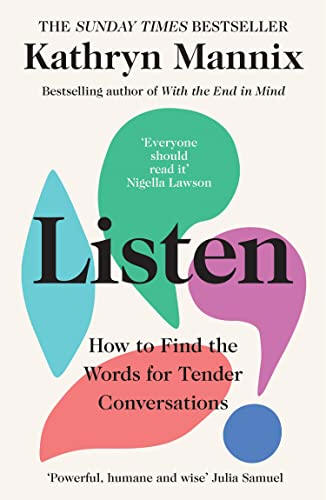Catholic Medical Quarterly Volume 72 (3) August 2022
Book Review
Listen: How to find the words for tender conversations
by Dr Kathryn Mannix
Reviewed by Andrew Plasom-Scott
 In the
November 2020 CMQ we carried a review of Dr Mannix’s first book, With the
End in Mind, in which she made the case for the importance of
conversations about death and dying, drawing on her many years in
palliative care. In this new book, Dr Mannix focuses on the importance of
listening, as a pre-requisite for any kind of conversation about sensitive
issues.
In the
November 2020 CMQ we carried a review of Dr Mannix’s first book, With the
End in Mind, in which she made the case for the importance of
conversations about death and dying, drawing on her many years in
palliative care. In this new book, Dr Mannix focuses on the importance of
listening, as a pre-requisite for any kind of conversation about sensitive
issues.
The subtitle is deliberate: Mannix wants us to move away from thinking about ‘difficult conver-sations’ or even ‘challenging conversations’ as advocated by some. Rather, she makes the point that when people are hurting, they are tender, and our engagement with them also needs to be tender. It is significant, and indicative of her approach, that one chapter is called ‘On Tenderness’ and explores these ideas. ‘When we engage in tender conversations with somebody,’ she writes, ‘we create a safe place for them to suffer: we don’t cause their suffering, but we can accompany and support them in it.’
As with her previous book, this draws extensively on her experience, as a doctor, trained in CBT, and as an educator. The content draws largely on her experience, and the way she communicates it in this book demonstrates her excellence as an educator.
In terms of the content, Mannix gives us a series of pointers on how to conduct the various stages of tender conversations (such as getting started, getting alongside, finishing safely etc) all supported by anecdotes from her own experience which clearly illustrate the points.
She then looks in more depth about conversations that help people to make changes, and conversa- tions in particularly tender contexts, such as anger, and grief; and, of course, last conversations.
I found the chapter on talking with the bereaved particularly valuable. Like many people, I suspect, I recognise the importance of not avoiding bereaved people, but I have to work to overcome my own feeling of inadequacy in order to engage with them. Having some clear guidelines, drawn from bereaved people’s experience and requests, has proved invaluable.
The structure of the book, and of each chapter within it, demonstrate her skills as an educator. She explains clearly and simply what the key point is that she wishes to make, and then uses illustrative anecdotes to expand on the point, and further commentary to pick up the subtleties. All the way through, the reader feels in the company of a skilled compassionate and wise guide, who points out the features of this work, and encour- ages the reader to engage and think about them.
This is an outstandingly good book, firstly for professional use: her case study of a family who think hospital staff have killed a loved one by neglect or negligence and are covering it up, is extremely powerful and helpful. But it also applies to the rest of our life, too: tender conversations are clearly essential in families and with friends, too.
